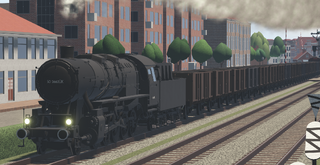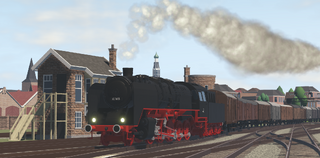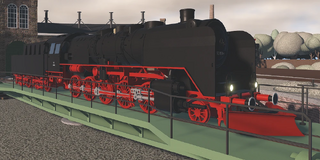| Baureihe 50 | |
|---|---|
| by Supersnel11 | |
| Price | ƒ300.000 |
| Level | 60 |
| Statistics | |
| Type | Freight |
| Top Speed | 80 km/h |
| Weight | 146 tons |
| Capacity | 760 tons |
| Length | 23,0 meters |
The NS 4900 were a class of six 1'E (2-10-0) freight locomotives of the German Baureihe 50 class. The class was a great success, with 3.164 being built between 1939 and 1948 for heavy goods trains all across the European mainland.
Variants
The BR 50 is available in two liveries, those being DR black and ÜK grey. During the winter updates of 2022, it received a snow plough livery based on its DR black livery.
Historical details
Baureihe 50
In 1925, Germany created a law aimed at its railways. Factories were only allowed to produce so-called "Einheitslokomotiven" ( 'standardized locomotives') so the reserve parts would not vary in designs so wildly. 15 tender engines, including the BR 50, and 14 tank engines were designed under those principles until 1942.
The BR 50, originally planned to be numbered BR 46, were put into service in 1939. They were meant to take goods trains across lines where the BR 44 were unable to go due to their high axle load of 20 tons. These often were smaller lines and branch lines, which did not always have a turntable. So the tenders were designed in such a manner that the locomotives could go the same speed forwards and backwards. With this, a successful, universal, modern goods locomotive was created. The DRB would have 3164 of these machines built in factories throughout Austria, Belgium, Czechoslovakia, Germany and Poland.
As war would start to take its toll on resources, simplified versions of the BR 44, 50 and 86 were designed. These "Übergangskriegsbauart" type ('Transitional war construction') locomotives were simplified to decrease production time and use more common, cheaper materials (see the Technical details for further information). The Ük BR 50s would form the basis of the even further simplified BR 52 class.
After 1944, the BR 52 was the only medium duty locomotive still in production, with the exception of Belgium, where 50 Üks were still being built.
The Dutch ones
NS 4900
In October of 1944, the 4901 and 4904 were found in the liberated parts of the Netherlands and put into service with the numbers 4802 & 4801. NS 4906 was added to NS' locomotive collection all the way in August of 1945.
The badly damaged NS 4903 was repaired in Zwolle using parts of the also badly damaged NS 4902. As a result of the damage and removal of parts for 4903, NS 4902 has never been operational under NS ownership.
The other five locomotives operated from depot Eindhoven, from where they mostly pulled coal trains from the south of Limburg. From November of '45 to March of '46, NS 4903 & 4904 were used in goods traffic between Zwolle and Onnen. By this time, the 4905 wasn't entirely operational anymore: without a blower, stoking the engine was quite a challenge.
After their return to Germany, all locomotives but 4902 were put back in service there. However, the leaving of the NS 4900s did not mean the end of these machines in the Netherlands.
NS & DRB Numbers
| NS | DRB |
|---|---|
| 4901 | 50 1586 |
| 4902 | 50 1613 |
| 4903 | 50 1680 Ük |
| 4904 | 50 1964 |
| 4905 | 50 2662 Ük |
| 4906 | 50 2447 Ük |
Post-war
From 1947 onwards, the BR 50s continued to be a familiar sight throughout all Dutch stations along the German border on a daily basis. It wasn't until 1973 that they would be withdrawn from service there too.
Because of a sudden defect on a boiler of an Esso refinery in Botlek, three BR 50s (50 408, 50 653 & 50 747) were hired from DB to deliver steam in 1961. They arrived at Rotterdam on the 30th of January, under their own power and with a considerable load of coal. On the nights of 9th to 10th February, they returned to Germany.
Heritage
SSN
Stoom Stichting Nederland (SSN) purchased the second-last operational BR 50 (50 1255) from the Federal Republic of Germany in 1977. Around 2003, they started with preparations to restore the locomotive. However, the maintenance of their remaining rolling stock had meant that not enough time nor money were available for the BR 50.
VSM
The Veluwsche Stoomtrein Maatschappij (Veluwen Steam train company, VSM) currently owns four BR 50s. Three of these are of the subseries 5035, which were given new, slightly larger boilers by the DDR. They used to have a fourth ex-5035, but this was restored back to its original appearance and given back its original number in 2012.
They used to have a fifth, oil burning BR 50 (50 0073), which was operational, but has been sold to another Dutch heritage railway, the ZLSM.
| Number | Old number | Note |
|---|---|---|
| 50 3520 | 50 1339 | Not operational; used for parts. |
| 50 307 | 50 3564 | Restored to this state in 2012. |
| 50 3654 | 50 3154 | |
| 50 3861 | 50 110 | Not operational; used for parts. |
Technical details
BR 50
The BR 50s were equipped with a Knorr-Tolkien pre-heater with a heating surface of 11 m² and a pump with a capacity of 250 litres a minute, though some had this installation replaced in favour of a second injector as the pre-heaters were vulnerable to freezing, which caused malfunctions in the cold winters of eastern Europe. Furthermore, the BR 50s had steam heating connections on the front and back of the tender, an air-powered bell, airbrakes (automatic and independent), electrical lighting and Deuta-speedometers.
Like all pre-war "Einheitslokomotiven", they had a bar or rod frame.
BR 50 Ük

In an attempt to decrease production time and rid the process of expensive, rare materials, the "Übergangskriegbauart" 50s had the following changes made to their design:
- Many non-ferrous parts were replaced with iron versions;
- The metal used for bearings was of a lower quality;
- The feeding dome was removed;
- The smoke deflectors were removed.
Later on, the design was simplified even further with the following changes:
- The water pre-heater was removed;
- The second sand dome was removed.
These locomotives were easily recognisable as they had 'Ük' painted behind their numbers and could even have an entirely different, grey livery, like the in-game Ük livery.
NS 4900
The NS 4903 and 4905 had no pre-heater, but two injectors. NS 4903 was additional unusual in the fact that, during reparations, it received the smoke deflectors of NS 4902, something most Ük locomotives did not have.
Trivia
- The NS 4900 is for high level players, as it is the epitome of steam powered freight locomotives, with its vast pulling power and immense size
- The NS 4900 is the first 'borrowed' German locomotive to be added to the game.
- In version 0.5.12, the NS 4900 received a temporary snowplough livery for the winter season of 2022.
- Strangely, the snowplough has not returned for any subsequent winter updates.
- The NS 4900 was released in version 0.4.10
- Its ÜK livery was released in version 0.4.66
Gallery
-
An NS 4900, German number 50 2662ÜK, leaves Dokmuiden with an ore train.
-
NS 4902 with a mixed goods train near Zand op 't Zee.
-
The NS 4900 in its plow livery





